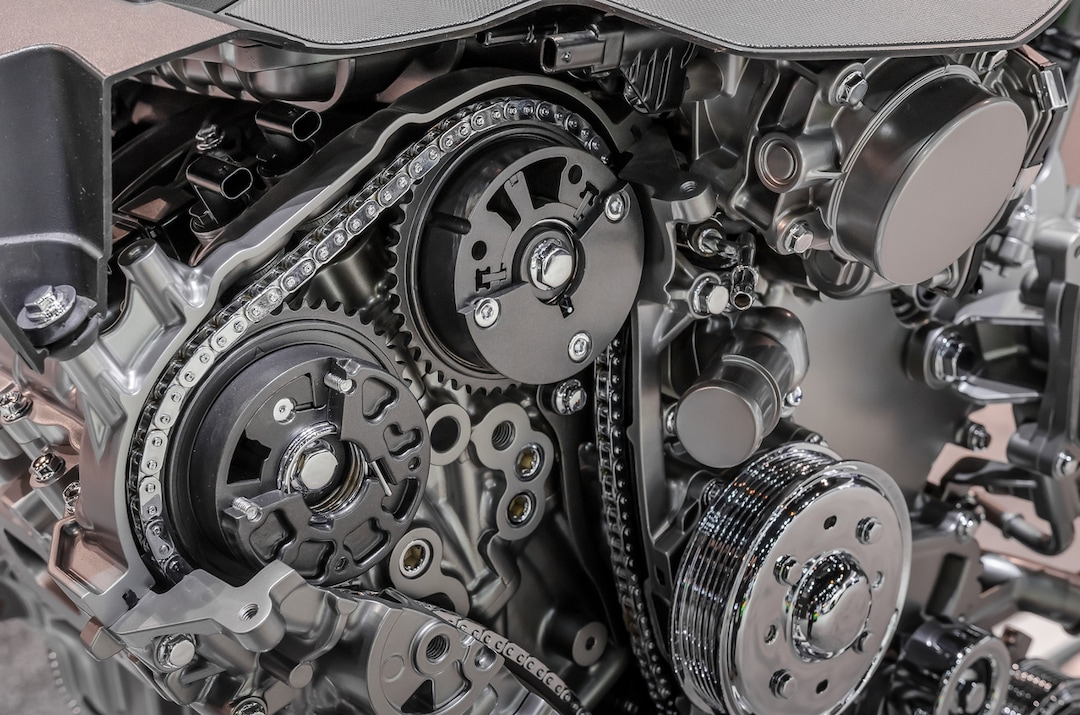In this blog post, we’ll explore the differences between timing belts and timing chains, their pros and cons, and when you should consider replacing them to avoid costly engine damage.
Timing Belt vs. Timing Chain: Key Differences
1. Timing Belt
- Material: Made of reinforced rubber with high-tensile fibers (like fiberglass or Kevlar).
- Operation: Runs quietly and smoothly.
- Maintenance: Requires periodic replacement (typically every 60,000 to 100,000 miles, depending on the manufacturer).
- Cost: Generally cheaper to replace than a timing chain but must be changed proactively.
- Risk: If it fails, the engine can suffer severe damage (interference engines).
Pros:
✅ Quieter operation
✅ Less expensive initial cost
✅ Lighter weight
Cons:
❌ Requires regular replacement
❌ Vulnerable to heat, oil, and coolant leaks
❌ Sudden failure can lead to catastrophic engine damage
-2. Timing Chain
- Material: Made of metal (similar to a bicycle chain but much stronger).
- Operation: More durable but can be noisier.
- Maintenance: Designed to last the lifetime of the engine (though some may stretch or wear out over time).
- Cost: More expensive to replace but rarely fails if maintained properly.
- Risk: Less likely to fail suddenly, but wear can cause timing issues.
Pros:
✅ Longer lifespan (often lasts 200,000+ miles)
✅ More resistant to heat and oil exposure
✅ Less risk of sudden failure
Cons:
❌ More expensive to repair if damaged
❌ Can be noisier than a belt
❌ Stretching or wear over time may require replacement
Signs Your Timing Belt Needs Replacement
1. Visible Wear or Cracks – If you inspect the belt (if accessible) and see fraying, glazing, or missing teeth, replace it immediately.
2. Engine Misfires or Poor Performance – A worn belt can cause the engine timing to slip, leading to misfires.
3. Ticking Noise from Engine – A failing belt tensioner or belt can produce unusual sounds.
4. Oil or Coolant Leaks – Contamination can degrade the rubber belt faster.
5. Mileage Interval – Follow your car’s manual (usually 60,000–100,000 miles).
Signs Your Timing Chain Needs Replacement
1. Rattling Noise on Startup– A loose or stretched chain may produce a metallic rattling sound.
2. Check Engine Light (Timing-Related Codes)– Codes like P0016 or P0017 indicate timing misalignment.
3. Engine Performance Issues – Rough idling, stalling, or power loss may indicate chain wear.
4. High Mileage – While chains last longer, they can wear out in engines with 200,000+ miles.
Which One Is Better?
Timing belts are common in older and some modern engines due to their quiet operation and lower initial cost, but they require strict maintenance.
Timing chains are more durable and often found in performance and long-lasting engines, but repairs can be costly if neglected.
Final Advice:
✔ Check your owner’s manual for recommended replacement intervals.
✔ Don’t ignore warning signs—timing system failure can destroy your engine.
✔ Replace water pump & tensioners along with the timing belt for a complete service.
By understanding the differences and staying proactive with maintenance, you can avoid expensive repairs and keep your engine running smoothly for years to come!
Have you experienced timing belt or chain failure? Share your story in the comments! 🚗💨


Comments
Post a Comment
Wish to leave a message?